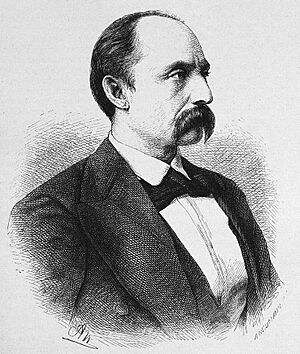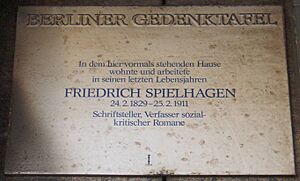Friedrich Spielhagen facts for kids
Quick facts for kids
Friedrich Spielhagen
|
|
|---|---|
 |
|
| Born | 24 February 1829 Magdeburg |
| Died | 25 February 1911 (aged 82) Berlin |
| Signature | |
Friedrich Spielhagen (born February 24, 1829 – died February 25, 1911) was a German writer, thinker, and translator. He tried out different jobs when he was in his early 20s. But by the time he was 25, he decided to focus on writing and translating books. His most famous novel is Sturmflut. Another one of his books, In Reih' und Glied, was very popular in Russia.
Friedrich Spielhagen's Early Life and Career
Friedrich Spielhagen was born in Magdeburg, Germany. He grew up in Stralsund, where his father worked as a government architect. Friedrich went to a school called a gymnasium in Stralsund. This is similar to a high school in some other countries.
After school, he studied law, and later literature and philosophy. He went to universities in Berlin, Bonn, and Greifswald.
While at the University of Bonn, he joined a student group called Franconia. Famous people like Carl Schurz were also part of this group. Carl Schurz later said that Spielhagen was a person with "rare intellectuality and moral elevation." This means he was very smart and had strong morals.
After finishing university, Friedrich tried many different jobs. He worked as a private tutor, an actor, a soldier, and a teacher. But when his father passed away in 1854, he decided to become a full-time writer.
In 1859, he became the editor of a newspaper in Hannover. Later, in 1862, he moved to Berlin. There, he edited a popular German magazine called Westermanns illustrirte deutsche Monatshefte from 1878 to 1884.
Friedrich Spielhagen also translated many books into German. He translated works by American writers like George William Curtis and Ralph Waldo Emerson. He also translated some French books. He married Therese Boutin and they had a daughter named Elsa. He passed away on February 25, 1911. Today, streets are named after him in cities where he lived, like Magdeburg, Stralsund, Hannover, and Berlin.
Friedrich Spielhagen's Famous Novels and Plays

Friedrich Spielhagen started by writing for newspapers and magazines. His first two novels, Clara Vere (1857) and Auf der Düne (1858), were not very popular.
But in 1861, he became very successful with his novel Problematische Naturen. This book was even translated into English as "Problematic Characters." He then wrote a sequel to it called Durch Nacht zum Licht. Many more novels followed, including Die von Hohenstein and Hammer und Amboß.
One of his most important novels was Sturmflut (1876). This story was based on the financial problems that happened in Berlin after the Franco-Prussian War. Today, Sturmflut is considered his best-known work.
He also wrote a play called Liebe für Liebe (Love for Love), which was performed in Leipzig in 1875.
Friedrich Spielhagen's novel In Reih' und Glied (1866) became incredibly popular in Russia. It was translated there with a title that means "One man alone can't win a war." This book featured a revolutionary character named Leo. Because of its success, almost all of his other novels were also translated into Russian.
Later in his life, Spielhagen focused more on writing about literary theory. This means he wrote about how novels and plays are put together. In 1890, he published his autobiography, Finder und Erfinder, which shared memories from his own life.

